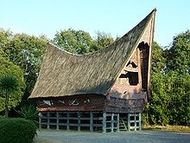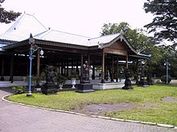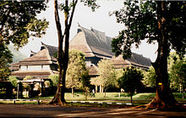
Although religious architecture has been widespread in Indonesia, the most significant was developed in Java. The island's long tradition of religious syncretism extended to architecture, which fostered uniquely Javanese styles of Hindu, Buddhist, Islamic, and to a lesser extent, Christian architecture.
A number of often large and sophisticated religious structures (known as candi in Indonesian) were built in Java during the peak of Indonesia's great Hindu-Buddhist kingdoms between the 8th and 14th centuries (see Ancient temples of Java). The earliest surviving Hindu temples in Java are at the Dieng Plateau. Thought to have originally numbered as many as 400, only 8 remain today. The Dieng structures were small and relatively plain, but architecture developed substantially and just 100 years later the second Kingdom of Mataram built the Prambanan complex near Yogyakarta; considered the largest and finest example of Hindu architecture in Java. The World Heritage-listed Buddhist monument Borobudur was built by the Sailendra Dynasty between 750 and 850 AD, but it was abandoned shortly after its completion as a result of the decline of Buddhism and a shift of power to eastern Java. The monument contains a vast number of intricate carvings that tell a story as one moves through to the upper levels, metaphorically reaching enlightenment. With the decline of the Mataram Kingdom, eastern Java became the focus of religious architecture with an exuberant style reflecting Shaivist, Buddhist and Javanese influences; a fusion that was characteristic of religion throughout Java.
By the fifteenth century, Islam had become the dominant religion in Java and Sumatra, Indonesia's two most populous islands. As with Hinduism and Buddhism before it, the new religion, and the foreign influences that accompanied it, were absorbed and reinterpreted, with mosques given a unique Indonesian/Javanese interpretation. At the time, Javanese mosques took many design cues from Hindu, Buddhist, and even Chinese architectural influences (see image of "Grand Mosque" in Yogyakarta). They lacked, for example, the ubiquitous Islamic dome which did not appear in Indonesia until the 19th century, but had tall timber, multi-level roofs similar to the pagodas of Balinese Hindu temples still common today. A number of significant early mosques survive, particularly along the north coast of Java. These include the Mesjid Agung in Demak, built in 1474, and the Menara Kudus Mosque in Kudus (1549) whose minaret is thought to be the watch tower of an earlier Hindu temple. Javanese mosque styles in turn influenced the architectural styles of mosques among its neighbors, among other the mosques in Kalimantan, Sumatra, Maluku, and also neighboring Malaysia, Brunei and the southern Philippines. Sultan Suriansyah Mosque in Banjarmasin and Kampung Hulu Mosque in Malacca for example displaying Javanese influence.
In 19th century, the sultanates of Indonesian archipelago began to adopt and absorb foreign influences of Islamic architecture, as alternative to Javanese style already popular in the archipelago. The Indo-Islamic and Moorish style are particularly favoured by Aceh Sultanate and Deli Sultanate, as displayed in Banda Aceh Baiturrahman Grand Mosque built in 1881, and Medan Grand Mosque built in 1906. Particularly during the decades since Indonesian independence, mosques have tended to be built in styles more consistent with global Islamic styles, which mirrors the trend in Indonesia towards more orthodox practice of Islam.

Palace architecture of the various kingdoms and realms of Indonesia, is more often than not based on the vernacular adat domestic styles of the area. Royal courts, however, were able to develop much grander and elaborate versions of this traditional architecture. In the Javanese Kraton, for example, large pendopos of the joglo roof form with tumpang sari ornamentation are elaborate but based on common Javanese forms, while the omo sebua ("chief's house") in Bawomataluo, Nias is an enlarged version of the homes in the village, the palaces of the Balinese such as the Puri Agung in Gianyar use the traditional bale form, and the Pagaruyung Palace is a three-storey version of the Minangkabau Rumah Gadang.
Similar to trends in domestic architecture, the last two centuries have seen the use of European elements in combination with traditional elements, albeit at a far more sophisticated and opulent level compared to domestic homes. In the Javanese palaces the pendopo is the tallest and largest hall within a complex. As the place where the ruler sits, it is the focus of ceremonial occasions, and usually has prohibitions on access to this space.

The 16th and 17th centuries saw the arrival of European powers in Indonesia who used masonry for much of their construction. Previously timber and its by-products had been almost exclusively used in Indonesia, with the exception of some major religious and palace architecture. One of the first major Dutch settlements was Batavia (later named Jakarta) which in the 17th and 18th centuries was a fortified brick and masonry city. For almost two centuries, the colonialists did little to adapt their European architectural habits to the tropical climate. In Batavia, for example, they constructed canals through its low-lying terrain, which were fronted by small-windowed and poorly ventilated row houses, mostly in a Chinese-Dutch hybrid style. The canals became dumping grounds for noxious waste and sewage and an ideal breeding ground for the anopheles mosquitos, with malaria and dysentery becoming rife throughout the Dutch East Indies colonial capital.
Although row houses, canals and enclosed solid walls were first thought as protection against tropical diseases coming from tropical air, years later the Dutch learnt to adapt their architectural style with local building features (long eaves, verandahs, porticos, large windows and ventilation openings).The Indo-European hybrid villa of the 19th century were among the first colonial buildings to incorporate Indonesian architectural elements and attempt adapting to the climate. The basic form, such as the longitudinal organisation of spaces and use of joglo and limasan roof structures, was Javanese, but it incorporated European decorative elements such as neo-classical columns around deep verandahs.Whereas the Indo-European homes were essentially Indonesian houses with European trim, by the early 20th century, the trend was for modernist influences—such as art-deco—being expressed in essentially European buildings with Indonesian trim (such as the pictured home's high-pitched roofs with Javan ridge details). Practical measures carried over from the earlier Indo-European hybrids, which responded to the Indonesian climate, included overhanging eaves, larger windows and ventilation in the walls.
At the end of the 19th century, great changes were happening across much of colonial Indonesia, particularly Java. Significant improvements to technology, communications and transportation had brought new wealth to Java's cities and private enterprise was reaching the countryside.Modernistic buildings required for such development appeared in great numbers, and were heavily influenced by international styles. These new buildings included train stations, business hotels, factories and office blocks, hospitals and education institutions. The largest stock of colonial era buildings are in the large cities of Java, such as Bandung, Jakarta, Semarang, and Surabaya. Bandung is of particular note with one of the largest remaining collections of 1920s Art-Deco buildings in the world, with the notable work of several Dutch architects and planners, including Albert Aalbers, Thomas Karsten, Henri Maclaine Pont, J Gerber and C.P.W. Schoemaker.
Colonial rule was never as extensive on the island of Bali as it was on Java— it was only in 1906, for example, that the Dutch gained full control of the island—and consequently the island only has a limited stock of colonial architecture. Singaraja, the island's former colonial capital and port, has a number of art-deco kantor style homes, tree-lined streets and dilapidated warehouses. The hill town of Munduk, a town amongst plantations established by the Dutch, is Bali's only other significant group of colonial architecture; a number of mini mansions in the Balinese-Dutch style still survive.
The lack of development due to the Great Depression, the turmoil of the Second World War and Indonesia's independence struggle of the 1940s, and economic stagnation during the politically turbulent 1950s and 60s, meant that much colonial architecture has been preserved through to recent decades.Although colonial homes were almost always the preserve of the wealthy Dutch, Indonesian and Chinese elites, and colonial buildings in general are unavoidably linked with the human suffering of colonialism, the styles were often rich and creative combinations of two cultures, so much so that the homes remain sought after into 21st century.
Native architecture was arguably more influenced by the new European ideas than colonial architecture was influenced by Indonesian styles; and these Western elements continue to be a dominant influence on Indonesia's built environment today.
 RSS Feed
RSS Feed